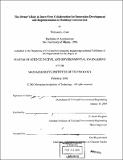| dc.contributor.advisor | E. Sarah Slaughter. | en_US |
| dc.contributor.author | Cate, William L. (William Lawrence), 1973- | en_US |
| dc.contributor.other | Massachusetts Institute of Technology. Dept. of Civil and Environmental Engineering. | en_US |
| dc.date.accessioned | 2012-09-13T18:51:53Z | |
| dc.date.available | 2012-09-13T18:51:53Z | |
| dc.date.copyright | 2001 | en_US |
| dc.date.issued | 2001 | en_US |
| dc.identifier.uri | http://hdl.handle.net/1721.1/72798 | |
| dc.description | Thesis (S.M.)--Massachusetts Institute of Technology, Dept. of Civil and Environmental Engineering, 2001. | en_US |
| dc.description | Includes bibliographical references (p. 154-157). | en_US |
| dc.description.abstract | Innovation, which is characterized as a significant improvement to an existing product, process, or system, often results in changes to several aspects of a project. Consequently, the development and implementation of an innovation typically requires collaboration across a variety of disciplines. In the context of the construction industry, collaboration not only takes place across a variety of disciplines, but also across multiple organizations responsible for delivering large, complex projects. Consequently, the interaction between design and construction firms influences the likelihood of innovation on construction projects. Because the owner of the facility generally creates the environment under which design and construction firms collaborate, the goal of this research is to identify the factors and mechanisms that may be established by the owner to foster innovation on construction projects. Seventeen projects by seven different owners were analyzed to determine the influence of owner capabilities, owner approach, team composition, project scope, and mechanisms of inter-firm collaboration on the frequency of innovation in construction projects. At the organizational level, the results confirm that it is best for the owner to invest in design and construction resources or to outsource with external organizations to obtain the competence needed to develop and implement construction innovations. It is also optimal for the owner to actively participate in the procurement process, integrate the design and construction process, and share risk and reward with its design and construction agents. In addition, it is important to select highly qualified professionals and establish the project team as early as possible. Although an environment of trust and teamwork enhances innovation, establishing new relationships with designers results in greater creativity as a prerequisite for innovation. At the project level, a long facility functional life, clear project objectives, and specified complexities in the project may be acknowledged by the owner to challenge its design team to develop innovation. Finally, mechanisms of inter-firm collaboration may be established, such as super-ordinate goals, informal rules and procedures, and communication tools to increase the likelihood of innovation. Under these conditions, the owner may rally its team members under a shared common purpose, provide flexibility in an environment of inherent project uncertainty, and provide an effective means of communication under which the project team collaborates for purposes of innovation. It is intended that this research will aid the formation of solutions to the problems that occur when organizations collaborate to develop and implement innovations in large, complex facilities. These research results are presented in the format of a "prescriptive handbook" for the owner to utilize in organizing and managing the innovation process. It is also anticipated that any participant in a product development industry, including construction and manufacturing, will be able to use this information to formulate an innovation collaboration strategy for becoming a leading-edge company in today's globally competitive marketplace. | en_US |
| dc.description.statementofresponsibility | by William L. Cate. | en_US |
| dc.format.extent | 282 p. | en_US |
| dc.language.iso | eng | en_US |
| dc.publisher | Massachusetts Institute of Technology | en_US |
| dc.rights | M.I.T. theses are protected by
copyright. They may be viewed from this source for any purpose, but
reproduction or distribution in any format is prohibited without written
permission. See provided URL for inquiries about permission. | en_US |
| dc.rights.uri | http://dspace.mit.edu/handle/1721.1/7582 | en_US |
| dc.subject | Civil and Environmental Engineering. | en_US |
| dc.title | The owner's role in inter-firm collaboration for innovation development and implementation in building construction | en_US |
| dc.type | Thesis | en_US |
| dc.description.degree | S.M. | en_US |
| dc.contributor.department | Massachusetts Institute of Technology. Department of Civil and Environmental Engineering | |
| dc.identifier.oclc | 48085706 | en_US |
